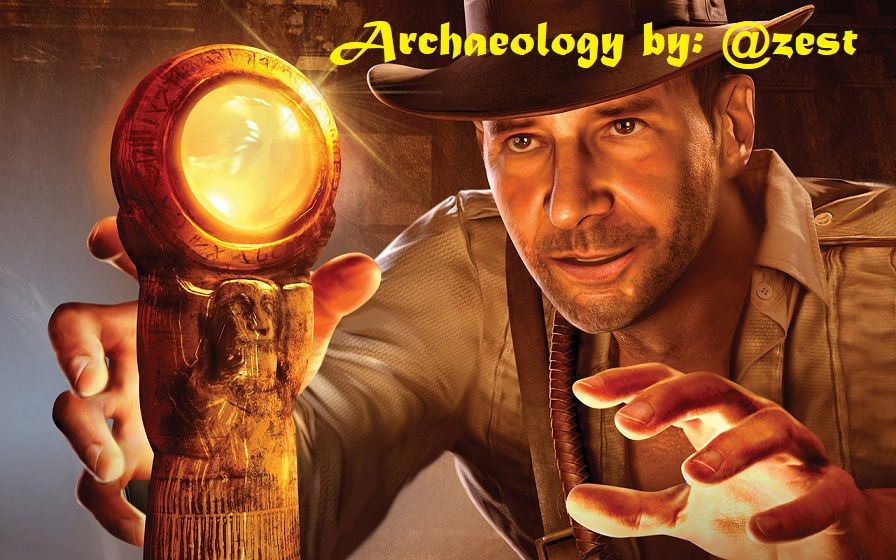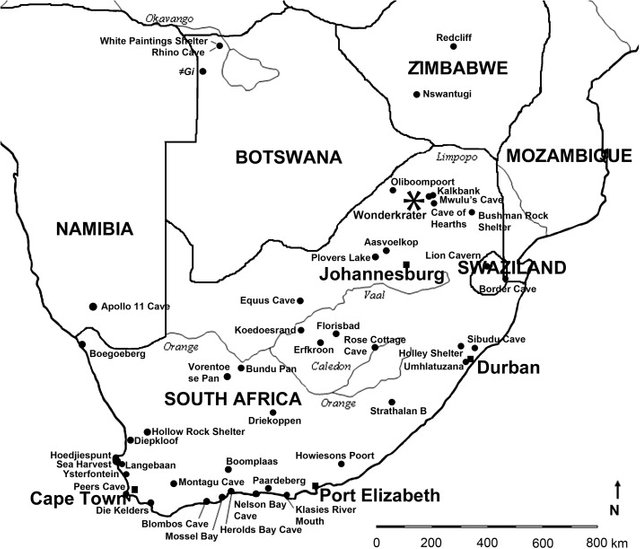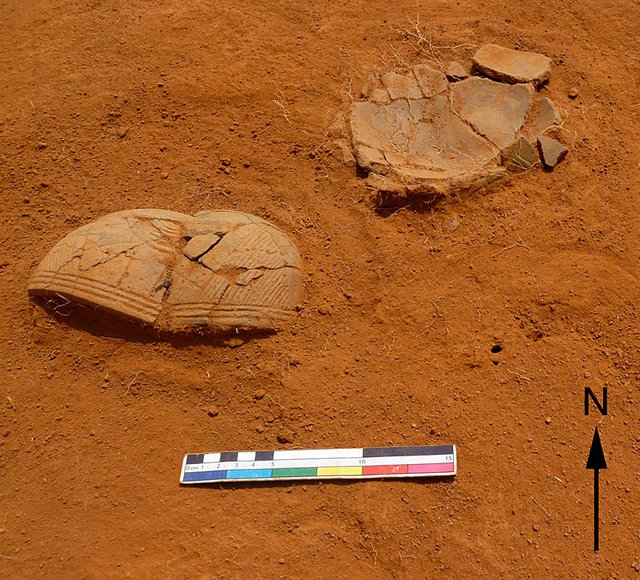
Dear Reader
In this following series of posts we are covering the Later Stone Age of South Africa, I highly encourage you to please read the Introduction post to this series to bring you update to date with the information and terminology we have covered so far.
The Early Iron Age of South Africa:The Origins of the Early Iron Age Complex
The Origins of the Early Iron Age Complex
The Early Iron Age of eastern and southern Africa is now generally known as the Chifumbaze Complex. The name "Chifumbaze" refers to a rock shelter in Mozambique where pottery typical of this of this complex was first excavated. The term "Chifumbaze" is also used to distinguish the Early Iron Age Complex of eastern and southern Africa from contemporary iron-using complexes in other parts of Africa (Phillipson 1993:171). According to David Phillipson (1977:216-219), there is no evidence that the Chifumbaze or Early Iron Age Complex originated outside Africa, Indonesia has sometimes been mentioned as a possible place of origin, but there is no linguistic, pottery or other material cultural evidence which points to the early presence of Indonesian settlers in eastern or southern Africa. Indonesian influences are indeed recognizable in Madagascar, but these date from the second half of the first millennium AD.
Phillipson (1977&1993) contends Chifumbaze complex originated somewhere in the Sudanic Belt, that is to say, in the area between the southern fringes of the Sahara Desert and the northern limits of the equatrial forests of Central Africa. To substantiate his argument, Phillipson points out that domestic sheep, goats and cattle, as well as those species of crops cultivated by Early Iron Age farmers, were already present in this area during the period immediately preceding the advent of the Early Iron Age complex. During a period of contact (c 1000-400BC) proto-Bantu speakers came into contact with Central Sudanic speakers in this area and adopted the Central Sudanic practices of herding cattle and sheep, as well as the cultivation of sorghum. One group of these proto-Bantu speakers moved eastwards at around 1000-200BC and settled in the proximity of the great lakes of East Africa, the so-called interlacustrine region. Another section moved directly southwards to the Lower Congo River. From these two source areas the Early Iron Age or Chifumbaze Complex rapidly expanded southwards at the beginning of the Christain era.
As a result the mixed farming complex of the Early Iron Age was introduced into southern Africa. It is interesting to note that sites containing Urewe pottery are found near Lake Victoria, close to the source area indicated above. Urewe pottery, sometimes also referred to as "dimple-base ware", is considered by Phillipson (1977:219) to be the possible "common ancestral tradition" from which other Early Iron Age pottery traditions evolved.
It is clear from the above that Phillipson associates the origins of the Early Iron Age Complex of eastern and southern Africa with the migration of Bantu speakers. There is, in fact, a large degree of consensus among linguists that, in the area currently comprising Cameroon, Chad and Nigeria, a proto-Bantu language was spoken, from which the Bantu languages south of the equator, including those of South Africa, developed.According to Phillipson, then, the Bantu languages thus originated close to the source area of the Early Iron Age Complex. Furthermore, the geographical distribution of the Early Iron Age Complex largely overlaps with the present Bantu-speaking area of central, eastern and southern Africa.
There are, however, major differences of opinion concerning other aspects of Phillipson's model of origins. Tom Huffman (1979:233), for example, has questioned the typological evidence on the basis of which East African Urewe pottery is regarded as the common ancestor of all Early Iron Age pottery in sub-Saharan Africa. If a West Africa origin for all proto-Bantu speakers is accepted, it is obvious that their ceramics will display a large number of common attributes. According to Huffman, therefore, it is unnecessary to look for yet another common ancestral tradition in East Africa to account for similarities between ceramics units of the Chifumbaze Complex.
According to Phillipson (1993:179), the large measure of resemblance between the Bantu languages of eastern and southern Africa, as well as their wide distribution in these parts of the continent, can be attributed to a rapid dispersal from a common source area within the past 3000 or 4000 years. He links this rapid dispersal with the expansion of the Chifumbaze Complex. However, in his discussion of the origins of the Early Iron Age Complex, Martin Hall (1987:24) points out that there is not always a correlation between the linguistic and the ceramic data, and that the spread of the Bantu languages was not necessarily associated with large-scale population movements from the Cameroon area, Hall suggests that the expansion of the Bantu languages could have been achieved through other mechanisms; for example, through "the development of linguae francae used by traders" or "the emergence of new languages accepted" over an area as "standard intercommunity speech". This matter will be considered again when we discuss the spread of the Early Iron Age Complex to southern Africa in the next post.
Images are linked to their sources in their description and references are stated within the text.
Thank you for reading
Thank you @foundation for this amazing SteemSTEM gif






I have to read them a few times in a row, and I have gone back to reference your other articles more often than I can count but, I look forward to your posts!
Out of curiosity, has there been a collection of pottery found in one location that had several different styles to it?
The possibility of traders influencing and expanding a language makes sense to me. That being said, I know little of such things. I just can't think of a situation where trade from an outside culture (different or similar) didn't have wide reaching effects. (I hope that made sense.)
Thank you for the lesson!
Downvoting a post can decrease pending rewards and make it less visible. Common reasons:
Submit
Hey @brisby!!!!
Firstly thank you so much for the awesome comment!!!!!!
Regarding your question :
Yes, there sites in Southern Africa that does have different styles of pottery within one site but this interaction occurs at a later stage which I will cover in my future posts. (Now you have to come back to find out)
I will keep you in suspense until then:)
Downvoting a post can decrease pending rewards and make it less visible. Common reasons:
Submit
Hi @zest!
One unrelated comment. I noticed an Apollo 11 cave on the map. Maybe you wrote it in an earlier post I would have missed, but what is it? I am very curious about it.
Downvoting a post can decrease pending rewards and make it less visible. Common reasons:
Submit
Hi @lemouth!!!!!!
The Apollo XI Cave site is quite a significant archaeological site located in Nambia. The site contained some of the earliest mobile art pieces in the form of 7 stone slabs with artwork done in charcoal and ochre dating back to between 27 500 - 25 500 Before Present. So it wasn't only Leonardo da Vinci that carried around the famous "Mona Lisa". But I am sure that the name of the cave "Apollo XI" is what caught your attention:)
While the German archaeologist Wolfgang Erich Wandt was working in the cave the Apollo XI space mission had just made their successful return to earth on the 24 July 1969 after landing on the moon, so Wolfgang named the cave after the mission.
Thank you so much for the support and comment:)
Downvoting a post can decrease pending rewards and make it less visible. Common reasons:
Submit
Thanks for the explanation. I am indeed not disappointed. Are there other caves with cool names like that (I guess that yes) :)
Downvoting a post can decrease pending rewards and make it less visible. Common reasons:
Submit
Hello dear. I had been reading your post, great write up about the history of Africa by the way. Anyway, can you help me out. How were you able to put a photo beside your text post? I know this is very irrelevant, but you answering me to this will really be a big help to me. thank you.
Downvoting a post can decrease pending rewards and make it less visible. Common reasons:
Submit
Hey @gailbelga!!!!!
Would you like me to send you a DM on Steemit.chat?
Or would you prefer me to explain here?
Downvoting a post can decrease pending rewards and make it less visible. Common reasons:
Submit
Oh sure. you can message me over discord as well My username is johannagailtongco#3780. I wanted you to mentor me on how to write great entries such as this one too. Huhuhu. Well, I know I am asking too much but :)
Downvoting a post can decrease pending rewards and make it less visible. Common reasons:
Submit
Please join us as a member of this chatroom : https://steemit.chat/channel/steemSTEM
Downvoting a post can decrease pending rewards and make it less visible. Common reasons:
Submit
Today I am proud to say that I learned something new for you. cheers! My daughter @gailbelga kept reading your write ups sir. Indonesia and Malaysia though has been said to have similarities because of the land mass that used to exist around this area.
Downvoting a post can decrease pending rewards and make it less visible. Common reasons:
Submit
Good day to you sir, it is a pleasure to meet @gailbelga's dad. I am humbled and grateful to you and your daughter for taking the time to read, comment and support my posts. Please feel free to DM on steemit chat. It will be a pleasure to chat to you:)
Downvoting a post can decrease pending rewards and make it less visible. Common reasons:
Submit
I am pretty busy but if I have questions, I will basically tell my daughter to message you. It is great to read your articles. I could share a lot of insights to my friends when we will talk about what I learned here on steemit. Cheers! You are also a paka king!
Downvoting a post can decrease pending rewards and make it less visible. Common reasons:
Submit
We've left the stone age, now we've entered the iron age. I'm glad I followed up almost all your posts on the "later stone age". What will come after the "Iron age"?
I think I should ask my mum though.
Nice post buddy
Downvoting a post can decrease pending rewards and make it less visible. Common reasons:
Submit
Hi bro, after the iron age we will leave pre-history and enter history, so actually, your mum will be a great person to ask.
Downvoting a post can decrease pending rewards and make it less visible. Common reasons:
Submit
Yeah buddy. I could use her history acumen
Downvoting a post can decrease pending rewards and make it less visible. Common reasons:
Submit
Great informative post.
But I recommend you should write about greeks and Arabic people too.
That would add much more weight to the history
Thanks
Downvoting a post can decrease pending rewards and make it less visible. Common reasons:
Submit
Hi @arslan786. Thank you for the comment. I am an archaeologist that is qualified in the pre history of Southern Africa so the areas that you have requested for me to write about is currently out of my area of expertise , maybe in the future I will consider doing some personal research on these areas:) though I can suggest my colleague @laylahsophia who is a qualified egyptologist as another blog that might be of your interest:)
Downvoting a post can decrease pending rewards and make it less visible. Common reasons:
Submit
Good Keep it up good work
Downvoting a post can decrease pending rewards and make it less visible. Common reasons:
Submit
Thank you so much:)
Downvoting a post can decrease pending rewards and make it less visible. Common reasons:
Submit
I know much more about Buddhist culture and I have a big research on them. Maybe I will post that some day.
Downvoting a post can decrease pending rewards and make it less visible. Common reasons:
Submit
That would be great. I will keep an eye out for those posts.
Downvoting a post can decrease pending rewards and make it less visible. Common reasons:
Submit
love reading these types of Articles ,, living in Uk we are surrounded by history
every town has a past some good some bad
Downvoting a post can decrease pending rewards and make it less visible. Common reasons:
Submit
Great content, fun to read. Thank you for getting this out to everyone. Keep up the good work. Thanks
Downvoting a post can decrease pending rewards and make it less visible. Common reasons:
Submit
Thank you so much for taking the time to read. I am so happy that you enjoyed it:)
Downvoting a post can decrease pending rewards and make it less visible. Common reasons:
Submit
Downvoting a post can decrease pending rewards and make it less visible. Common reasons:
Submit
You read the post in 30 seconds, Wow!!!!!!
Downvoting a post can decrease pending rewards and make it less visible. Common reasons:
Submit
Hahahaha! I like your humor @zest!
Downvoting a post can decrease pending rewards and make it less visible. Common reasons:
Submit